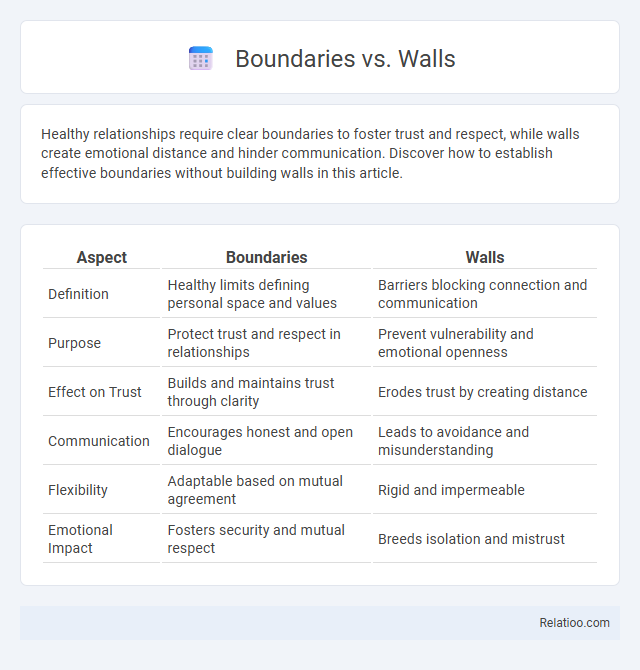Healthy relationships require clear boundaries to foster trust and respect, while walls create emotional distance and hinder communication. Discover how to establish effective boundaries without building walls in this article.
Table of Comparison
| Aspect | Boundaries | Walls |
|---|---|---|
| Definition | Healthy limits defining personal space and values | Barriers blocking connection and communication |
| Purpose | Protect trust and respect in relationships | Prevent vulnerability and emotional openness |
| Effect on Trust | Builds and maintains trust through clarity | Erodes trust by creating distance |
| Communication | Encourages honest and open dialogue | Leads to avoidance and misunderstanding |
| Flexibility | Adaptable based on mutual agreement | Rigid and impermeable |
| Emotional Impact | Fosters security and mutual respect | Breeds isolation and mistrust |
Understanding the Difference: Boundaries vs Walls
Boundaries are flexible limits set to protect personal space and emotional well-being while maintaining healthy relationships; walls, in contrast, are rigid barriers that block communication and emotional connection, often leading to isolation. Understanding the difference between boundaries and walls is essential for fostering trust and respect without creating distance or alienation. Effective boundaries promote self-care and mutual respect, whereas walls hinder genuine interaction and personal growth.
The Psychology Behind Boundaries and Walls
Walls often symbolize rigid, impermeable barriers that hinder communication and foster isolation, while boundaries represent flexible, clearly defined limits that protect personal space and emotional well-being. Psychologically, healthy boundaries promote self-respect and interpersonal trust by allowing individuals to assert needs without alienation. In contrast, walls stem from fear or past trauma, creating emotional distance that prevents genuine connection and growth.
Why We Build Emotional Walls
Emotional walls are constructed to protect individuals from potential psychological harm by creating barriers that prevent vulnerability and emotional exposure. Unlike healthy boundaries, which define personal limits and promote respectful interactions, walls often isolate and disconnect people, hindering genuine relationships. Understanding the difference between boundaries and walls is essential for fostering emotional well-being and maintaining balanced interpersonal connections.
The Benefits of Healthy Boundaries
Healthy boundaries foster clear communication and mutual respect, essential for maintaining strong relationships and personal well-being. Unlike walls, which create isolation, boundaries allow individuals to protect their space while staying connected with others. Establishing healthy boundaries reduces stress, prevents burnout, and promotes emotional resilience.
Signs You’ve Built a Wall, Not a Boundary
You may have built a wall, not a boundary, if your actions isolate others and prevent open communication rather than fostering respect and understanding. Walls often involve complete emotional shutdowns, while boundaries clearly define limits to protect your well-being without cutting off connection. Recognizing these signs helps you establish healthy boundaries that maintain relationships and promote mutual respect.
Consequences of Rigid Walls in Relationships
Rigid walls in relationships create emotional distance that hinders effective communication and trust-building. Your inability to express vulnerability or accept others' perspectives can lead to isolation, resentment, and weakened bonds. Embracing flexible boundaries instead fosters mutual respect and deeper connection while avoiding the negative consequences of inflexible barriers.
Setting Boundaries: Strategies for Success
Setting boundaries involves clear communication of personal limits to maintain healthy relationships and prevent burnout. Successful strategies include assertiveness training, consistent reinforcement, and self-awareness to recognize when limits are being crossed. Unlike walls that isolate, boundaries create respectful space fostering mutual understanding and emotional well-being.
Breaking Down Walls: Steps Toward Vulnerability
Breaking down walls involves recognizing that boundaries define limits to protect your well-being, while walls create rigid barriers that isolate and block connection. Embracing vulnerability requires dismantling these walls piece by piece by fostering open communication, trusting others, and allowing emotional transparency without sacrificing your personal boundaries. This process strengthens relationships by balancing self-protection with genuine intimacy and understanding.
Navigating Boundaries in Work and Personal Life
Navigating boundaries in work and personal life requires clear communication and mutual respect to maintain healthy relationships and productivity. Establishing flexible yet firm boundaries helps prevent burnout and supports work-life balance, while differentiating between boundaries and walls is crucial to avoid emotional isolation. Prioritizing self-awareness and regularly reassessing limits allows individuals to adapt their boundaries effectively across different social and professional contexts.
Transforming Walls into Empowering Boundaries
Transforming walls into empowering boundaries requires understanding the difference between isolation and protection, where walls symbolize emotional barriers that shut people out, while boundaries create healthy limits fostering respect and personal growth. Your ability to set clear, flexible boundaries promotes self-care and strengthens relationships, unlike walls that hinder communication and connection. Emphasizing boundaries over walls helps you maintain autonomy while inviting positive interactions and mutual understanding.

Infographic: Boundaries vs Walls
 relatioo.com
relatioo.com